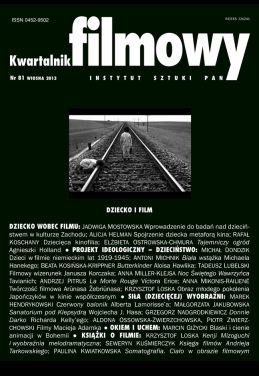Spojrzenie dziecka metaforą kina.
A child's gaze as a metaphor of the cinema.
Author(s): Alicja HelmanSubject(s): Theatre, Dance, Performing Arts
Published by: Instytut Sztuki Polskiej Akademii Nauk
Keywords: Childhood; Film Theory
Summary/Abstract: The author examines the creative strategy relying on using a figure of a child, and using its gaze to fill the function of the dispositive. This strategy can both steer the expression as a whole, but it can also be appliedto fragments of the work, which thus obtain a specific characteristic. The author sees the effect of this strategy in two quite different versions. In her view, these strategies correspond perfectly with the ideas proposed by theoreticians of cinema. The dispositive using the child’s gaze as an unprejudiced eye corresponds with André Bazin’s notion presented in "The Ontology of the Photographic Image", whereas the dispositive in its magical function agrees with the suggestions and ideas of Edgar Morin, which we may find in his book "The Cinema or the Imaginary Man". The author analyses the first strategy using the examples of the work of Carlos Saura and André Téchiné, also pointing to its variation in Chinese films. She illustrates the magical vision using Carlos Saura’s "Cría cuervos" ("Raise Ravens") and Víctor Erice’s "The Spirit of the Beehive".
Journal: Kwartalnik Filmowy
- Issue Year: 2013
- Issue No: 81
- Page Range: 24-38
- Page Count: 15
- Language: Polish

